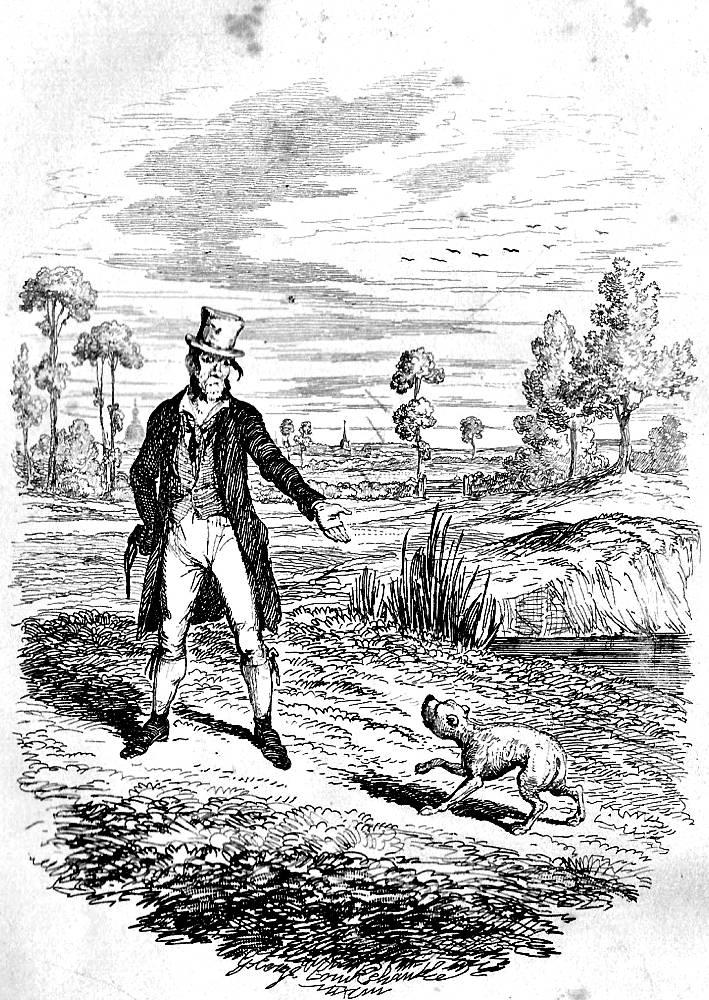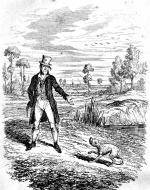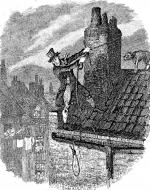Created by Kaitlyn Moorhead on Wed, 04/08/2020 - 23:27
Description:
Man's best friend was not always man's most well-treated friend. Though beloved by most everyone, dogs have had a long, hard history--one which has been captured by countless authors and illustrators in Victorian literature, who use the innocent canine as a lens that shows us mankind's true nature. There are many books, such as Oliver Twist and The King of the Golden River, which feature the abuse or mistreatment of dogs in order to warn readers against the cruel nature of some humans and raise awareness of canine protection.
George Cruikshank, "Sikes Attempting to Destroy his Dog," for Oliver Twist, 1838, by Charles Dickens, The Victorian Web, scanned by Phillip V. Allingham. Cruikshank's image appears approximately two thirds of the way through Dickens' Oliver Twist, when criminal Bill Sikes becomes a fugitive from the law. In order to prevent his dog, Bull's-eye, from following him on the run--which would be a dead giveaway to Sikes's identity--Sikes attempts to drown Bull's-eye in a nearby pond. In this first plate of the case, Bull's-eye, who looks terrified in Cruikshank's illustration, escapes and continues to follow his master. But Bull's-eye is not simply a wandering canine: he is a symbol of Sikes's abuse and manipulation. The presence of a dog in Sikes's life acts as a mirror to Nancy, the prostitue who loves Bill Sikes, only to be killed by him. By including a dog in Oliver Twist, Dickens exemplifies how characters such as Sikes often get away with the mistreatment of not only animals, but humans. Oftentimes, we do not realize how awful a person is until we see the way they treat their dog. And even then, we sometimes learn the truth too late.
George Cruikshank, "The Last Chance," for Oliver Twist, 1838, by Charles Dickens, The Victorian Web, scanned by Phillip V. Allingham. "The Last Chance" acts as a follow-up to "Sikes Attempting to Destroy his Dog." In Bill Sikes's final moments, the man tries to scale a building to flee the police. He looks up and sees Bull's-eye, but believes his dog's eyes to be those of Nancy, whom he has recently killed. In shock and fear, Sikes stumbles into his rope, and it becomes a noose, ending his life rather than preserving it. In an attempt to follow his master's escape, Bull's-eye throws himself off the building and dies moments after Sikes. The presence of Bull's-eye in this scene is crucial. Dickens is once again creating a parallel between human and dog-kind. The scene likens the fate of Bull's-eye with Nancy, whose love for Bill Sikes cost her her life. Bull's-eye shares a similar fate, taking abuse and cruelty at the hands of Sikes, only to follow him to the grave. In this moment, readers are meant to sympathize for Bull's-eye, a dog who believes he has no choice but to follow his master to the ends of the earth, just as poor Nancy has. By witnessing the fate of Bull's-eye, we as readers can recognize the necessity of keeping pure-hearted people and animals away from men as cruel as Bill Sikes. For too long, Dickens seems to say, men like Sikes have ruled the world... and in doing so, it has cost innocent beings their lives.
Richard Doyle, "Hans Drinks From His Flask," for The King of the Golden River , 1851, by John Ruskin, The Victorian Web, scanned by George P. Landow. There are many tests on the quest for prosperity. This lesson is not understood by Hans and Schwartz in Ruskin's literary fairy tale, The King of the Golden River. On an adventure to deliver holy water up a mountain, both unkind brothers are faced with obstacles: they are asked to give some of their holy water to dying, dehydrated creatures along their path. In one such instance illustrated in this third plate, Hans comes across a sickly dog that eyes the man's holy water in desperation. Hans refuses to give the dog any water, instead taking a drink for himself as he "spurned the animal with his foot." Hans's cruelty is abundant throughout Ruskin's fairy tale, but this rejection of a weak and dying dog hits especially hard to readers. Hans presents himself as a man not willing to help anyone, no matter how innocent or weak a creature may be. In doing so, the cruel brother affirms his fate: his quest for riches will fail, because a truly rich man finds his wealth in morality and would, therefore, cherish the life of any animal.
Sir Edwin Landseer, Dash , 1836, commissioned by the Duchess of Kent for Queen Victoria. This painting of a King Charles Spaniel which concludes this case is no ordinary household canine. Dash was one of the cherished dogs owned by Queen Victoria while she ruled over England. Victoria's adoration of her pets coincided with a turning point in the timeline of animal rights. Victoria's reign began in 1837 in the decade after the development of the Society for the Prevention of Cruelty to Animals. Additionally, the possession of lapdogs had become increasingly popular, meaning dogs had gained attention across Victorian society. As such, the treatment of dogs was at the forefront of everyone's mind. Those cruel to their dogs were recognized as cruel people in general, and kindhearted owners of pups were acknowledged as the best of us. Gradually, more and more laws were passed as concern for the treatment of canines grew. Victorian England finally appeared to reach a turning point with the Humane Act of 1835, which outlawed the fighting of any and all animals. As dog fighting was a key animal rights issue throughout England, and the passage of this act marked a transition in the English people to embrace dogs as nearly equal to mankind. Cruelty to them would be as horrific as cruelty to our own kind.



